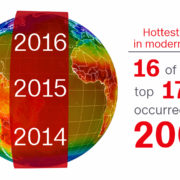U.S. scientists officially declare 2016 the hottest year on record. That makes three in a row…
In a powerful testament to the warming of the planet, two leading U.S. science agencies Wednesday (1/18/17) jointly declared 2016 the hottest year on record, surpassing the previous record set just last year — which itself had topped a record set in 2014.
Average surface temperatures in 2016, according to the National Oceanic and Atmospheric Administration, the warmest since the agency’s records began in 1880.
The average temperature across the world’s land and ocean surfaces was 58.69 Fahrenheit, or 1.69 degrees above the 20th-century average of 57 degrees, NOAA declared. The agency also noted that the record for the global temperature has now successively been broken five times since the year 2000. The years 2005 and 2010 were also record warm years, according to the agency’s data set.
NASA concurred with NOAA, also declaring 2016 the warmest year on record in its own data set that tracks the temperatures at the surface of the planet’s land and oceans, and expressing “greater than 95 percent certainty” in that conclusion. (In contrast, NOAA gave a 62 percent confidence in the broken record.)
NASA found a bigger leap upward of temperatures in 2016, measuring the year as .22 degrees Fahrenheit higher than the prior record year of 2015. The agency also noted that since the year 2001, the planet has seen “16 of the 17 warmest years on record.”
Scientists have been far less guarded. “2016 is a wake-up call in many ways,” Jonathan Overpeck, a climate scientist at the University of Arizona, said of the year’s temperatures. “Climate change is real, it is caused by humans, and it is serious.”
NASA and NOAA produce slightly different records using somewhat different methodologies, but have now concurred on identifying 2014, 2015 and 2016 as, successively, the three warmest years in their records. There was a noticeable difference this year, however, in how much two agencies judged 2016 to have surpassed 2015. NASA was more bullish — a difference that Schmidt, in a press call Wednesday, attributed to different ways of measuring the Arctic.
“The warming in the Arctic has really been exceptional, and what you decide to do when you’re interpolating across the Arctic makes a difference,” Schmidt said.
Last year’s warmth was partly enhanced by a strong weather pattern known as El Niño, but the federal scientists underscore that this was not the only cause.
For example, 1998 was also, at the time, the warmest year on record, thanks in part to a strong El Niño — but the 2016 planetary temperature now far surpasses the temperature of that year, as you can see above.
The reason is that Earth has been warming since then, allowing another El Niño event, unlocking heat from the vast Pacific Ocean, to push overall temperatures to new heights.
“The pattern of record warmth in the lower atmosphere, coupled with record cold in the stratosphere, provides a clear fingerprint of the cause of the unprecedented warming — greenhouse gases trapping heat in the lower atmosphere instead of letting it escape to the stratosphere, and then to space.
“No doubt about it anymore — humans, mainly by burning fossil fuels, are cooking the planet,” Overpeck said.




Leave a Reply
Join the Community discussion now - your email address will not be published, remains secure and confidential. Mahalo.